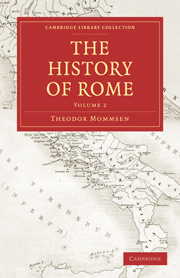Book contents
- Frontmatter
- Contents
- MAP OF ITALY
- BOOK THIRD: FROM THE UNION OF ITALY TO THE SUBJUGATION OF CARTHAGE AND OF THE GREEK STATES
- CHAPTER I CARTHAGE
- CHAPTER II THE WAR BETWEEN ROME AND CARTHAGE CONCERNING SICILY
- CHAPTER III THE EXTENSION OF ITALY TO ITS NATURAL BOUNDARIES
- CHAPTER IV HAMILCAR AND HANNIBAL
- CHAPTER V THE WAR UNDER HANNIBAL TO THE BATTLE OF CANNÆ
- CHAPTER VI THE WAR UNDER HANNIBAL FROM CANNÆ TO ZAMA
- CHAPTER VII THE WEST FROM THE PEACE OF HANNIBAL TO THE CLOSE OF THE THIRD PERIOD
- CHAPTER VIII THE EASTERN NATIONS AND THE SECOND MACEDONIAN WAR
- CHAPTER IX THE WAR WITH ANTIOCHUS OF ASIA
- CHAPTER X THE THIRD MACEDONIAN WAR
- CHAPTER XI THE GOVERNMENT AND THE GOVERNED
- CHAPTER XII THE MANAGEMENT OF LAND AND OF CAPITAL
- CHAPTER XIII FAITH AND MANNERS
- CHAPTER XIV LITERATURE AND ART
- CORRECTIONS
CHAPTER XI - THE GOVERNMENT AND THE GOVERNED
Published online by Cambridge University Press: 05 October 2010
- Frontmatter
- Contents
- MAP OF ITALY
- BOOK THIRD: FROM THE UNION OF ITALY TO THE SUBJUGATION OF CARTHAGE AND OF THE GREEK STATES
- CHAPTER I CARTHAGE
- CHAPTER II THE WAR BETWEEN ROME AND CARTHAGE CONCERNING SICILY
- CHAPTER III THE EXTENSION OF ITALY TO ITS NATURAL BOUNDARIES
- CHAPTER IV HAMILCAR AND HANNIBAL
- CHAPTER V THE WAR UNDER HANNIBAL TO THE BATTLE OF CANNÆ
- CHAPTER VI THE WAR UNDER HANNIBAL FROM CANNÆ TO ZAMA
- CHAPTER VII THE WEST FROM THE PEACE OF HANNIBAL TO THE CLOSE OF THE THIRD PERIOD
- CHAPTER VIII THE EASTERN NATIONS AND THE SECOND MACEDONIAN WAR
- CHAPTER IX THE WAR WITH ANTIOCHUS OF ASIA
- CHAPTER X THE THIRD MACEDONIAN WAR
- CHAPTER XI THE GOVERNMENT AND THE GOVERNED
- CHAPTER XII THE MANAGEMENT OF LAND AND OF CAPITAL
- CHAPTER XIII FAITH AND MANNERS
- CHAPTER XIV LITERATURE AND ART
- CORRECTIONS
Summary
Formation of new parties
The fall of the patriciate by no means divested the Roman commonwealth of its aristocratic character. We have already commonwealth of its aristocratic character. We have already that character from the first as well as, and in some sense still more decidedly than, the patriciate; for, while in the old body of burgesses an absolute equality of rights prevailed, the new constitution set out with a distinction between the senatorial houses who were privileged in point of burgess rights and of burgess usufructs, and the mass of the other citizens. Immediately, therefore, on the abolition of the patriciate and the formal establishment of civic equality, a new aristocracy and a corresponding opposition were formed; and we have already shown how the former engrafted itself as it were on the fallen patriciate, and how, accordingly, the first movements of the new party of progress were mixed up with the last movements of the old plebeian opposition (i. 315). The formation of these new parties began in the fifth century, but they assumed their definite shape only in the century which followed. The development of this change is, as it were, drowned amidst the tumult of great wars and victories, and the formative process is in this case more concealed from our view than in any other in Roman history. Like a crust of ice gathering imperceptibly over the surface of a stream and imperceptibly restricting it more and more, this new Roman aristocracy silently arose; and not less imperceptibly, like the concealed current slowly swelling beneath, there arose in opposition to it the new party of progress.
- Type
- Chapter
- Information
- The History of Rome , pp. 315 - 361Publisher: Cambridge University PressPrint publication year: 2010First published in: 1862



